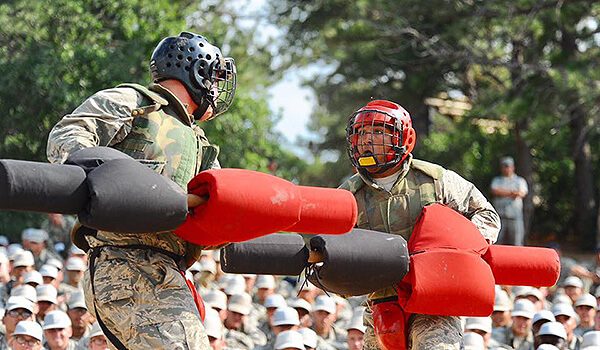What the new core curriculum means for the USAFA Class of 2021 and beyond
Interview by Marsha Barancik, Jan. 29, 2018
U.S. AIR FORCE ACADEMY, Colo. — The U.S. Air Force Academy launched a new core curriculum the fall of 2017, beginning with the class of 2021, to develop cadets through more integrated academic, military, flight training and physical education experiences. All cadets, regardless of academic major, are required to complete the core curriculum. This curriculum is designed to build proficiencies in each of the nine U.S. Air Force Academy’s Institutional Outcomes. Dr. Steve Jones, Academy Senior Associate Dean, shares how the Academy’s institutional outcomes are being integrated.

What is fundamentally different with the new core curriculum?
Dr. Jones: A distinct set of courses and programs are formally associated with each outcome, as shown here. The core consists of nine mini-curricula, with each one consisting of courses and programs designed to meet a different outcome. For example, cadets begin learning about the Warrior Ethos as Airmen and Citizens outcome in Basic Cadet Training, and their learning continues in History 100, Military and Strategic Studies 251, and each required Physical Education course. And, the new Officership curriculum, aligned with the Leadership, Teamwork, and Organizational Management outcome, rolled out for fourth-class cadets this fall. At large, cadets are increasingly being asked to draw on what they learn in one Mission Element to inform their experience in another Mission Element. For example, concepts taught in a leadership course apply to their squadron role.
What gaps did the new core curriculum expose?
Dr. Jones: Through the process of redesigning the core curriculum, we discovered potential gaps in the cadet development experience and created new lesson content to fill those gaps. Engineering Decision Analysis is one example of content that was modified. It was previously introduced in Engineering 101, a course that was dropped in the new core curriculum. Thus, the Engineering Mechanics 220 curriculum was reworked to cover decision making.

Are all courses integrated into the curriculum?
Dr. Jones: The core curriculum’s academic portion covers 29 courses and represents approximately two-thirds of all semester hours that cadets must complete in order to graduate. For a course or program to be included in the core curriculum, each department or Mission Element must demonstrate how it helps fulfill Academy outcomes. Faculty and staff leading those courses and programs are expected to work together — across traditional academic or mission element boundaries — to ensure that their part of the core curriculum fits together and really does develop the outcomes. This process led us, as department curriculum chiefs, course directors, and first-line instructors, to consider how each course leads into the next, how various desired skills and proficiencies are developed in each course, and what experiential development looks like. Clarifying the characteristics we want cadets to have when they graduate enables the Academy to be more purposeful and to provide the best possible four-year developmental experience for cadets.

Examples of other colleges and universities that modernize and integrate outcomes into their respective core curricula?
Dr. Jones: Accrediting bodies mandate that all colleges and universities have clear outcomes defining what it means to be a graduate of their institution. Specific outcomes described by different colleges and universities obviously vary, based on their distinctive values, cultures and missions. Our institutional outcomes reflect that we are both a prestigious undergraduate institution committed to the ideals of a high-quality education and an elite military training facility dedicated to providing commissioned officers, motivated to lead the U.S. Air Force in service to the nation. With the exception of the other service academies, our core curriculum is generally much larger than the general education requirements at other colleges and universities. There are plenty of examples of institutions that have adopted an outcome-based approach to their general education curricula. Some of the most interesting examples can be found at the University of Nebraska, James Madison University, and Butler University.
Are there other examples of how the outcomes are fulfilled outside the classroom?
Dr. Jones: Participate in the 2018 National Character & Leadership Symposium (NCLS) via Livestream on February 22 – 23, 2018 and hear from cadets and faculty how the institutional outcomes apply to officer development at the U.S. Air Force Academy.
The United States Air Force Academy annually celebrates and rewards the research accomplishments of top faculty and cadets. The Read here about the new award winners featured in this video.